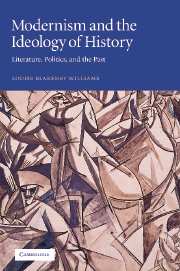Book contents
- Frontmatter
- Contents
- Acknowledgements
- Abbreviations
- Introduction
- 1 “Immaterial pleasure houses”: the initial aesthetic dilemma
- 2 “A more dream-heavy hour”: medievalist and progressive beginnings
- 3 “Pedantry and hysteria”: contemporary political problems
- 4 “A certain discipline”: radical conservative solutions
- 5 “A particularly lively wheel”: cyclic views emerge
- 6 “Our own image”: the example of Asian and non-Western cultures
- 7 In “the grip of the … vortex”: the proof of Post-Impressionist art
- 8 The “cycle dance”: cyclic history arrives
- 9 “The Nightmare” and beyond: the First World War and mature cyclic theories
- Conclusion
- Notes
- Index
7 - In “the grip of the … vortex”: the proof of Post-Impressionist art
Published online by Cambridge University Press: 22 September 2009
- Frontmatter
- Contents
- Acknowledgements
- Abbreviations
- Introduction
- 1 “Immaterial pleasure houses”: the initial aesthetic dilemma
- 2 “A more dream-heavy hour”: medievalist and progressive beginnings
- 3 “Pedantry and hysteria”: contemporary political problems
- 4 “A certain discipline”: radical conservative solutions
- 5 “A particularly lively wheel”: cyclic views emerge
- 6 “Our own image”: the example of Asian and non-Western cultures
- 7 In “the grip of the … vortex”: the proof of Post-Impressionist art
- 8 The “cycle dance”: cyclic history arrives
- 9 “The Nightmare” and beyond: the First World War and mature cyclic theories
- Conclusion
- Notes
- Index
Summary
All experience rushes into this vortex. All the energized past, all the past that is living and worthy to live….
The design of the future is in the grip of the human vortex. All the past that is vital, all the past that is capable of living into the future, is pregnant in the vortex, now.
Ezra Pound, “Vortex. Pound.,” 1914.In March 1914, after much preparation, the Rebel Art Centre was finally opened and ready, “by public discussion, lectures, and gatherings of people,” to fulfill an important mission – to “familiarize those who are interested with the ideas of the great modern revolution.” Revolutionaries soon did gather at this Centre. According to one account, they included “women with bare feet in black silver-latcheted shoes; women with hair cut like sixteenth-century pages; women with hats once worn apparently by their less sophisticated Quaker great-grandparents; men with lilac-coloured trousers … very baggy over the ankle; men in green collars, with ebony walking sticks.” They listened to lectures held in rooms in which “the doors and chairs are painted a bright vermilion red … the walls are lemon-coloured, and on the walls hang Cubist puzzles.”
The revolution that the Rebel Art Centre was promoting, of course, was one of aesthetics. In particular it supported the new visual art movement known as Post-Impressionism.
- Type
- Chapter
- Information
- Modernism and the Ideology of HistoryLiterature, Politics, and the Past, pp. 138 - 159Publisher: Cambridge University PressPrint publication year: 2002



